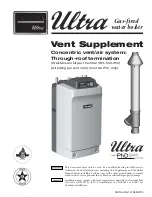
9
Flue Connection And Venting - Continued
Simple vent system consists of 6-foot minimum vertical
rise immediately off draft-hood, as shown in Figure 3.
Terminate this vertical fl ue above building roof with suitable
rain cap at least 2 feet above surrounding obstructions,
i.e., parapets, adjacent buildings, penthouses, etc. This
type of vent system applies to single draft-hood boilers
ONLY, and has limited practical use, because it is restricted
to single-story boiler rooms and because of problems
encountered in roof fl ashing.
Vertical venting system shown in Figure 3 cannot be used
on multiple-base boilers because of physical interference of
multiple rain caps.
For multiple-base boilers, pant leg venting system shown in
Figure 4 can be applied, if desired.
Vent system shown in Figure 5 is commonly used. With
vent diameters sized to match fl ue outlets, minimum
vertical rise of 4 feet above draft-hood must be maintained
for proper operation. Refer to Chart 1 for typical chimney
sizes. Requirements for this type of system are: an
adequately sized chimney, adequate combustion air, and
outlet end of horizontal run must be no more than 6 feet
from chimney with no more than one 90° elbow in this run
as shown.
For installations where required minimum 4-foot vertical
rise cannot be maintained, diameter of horizontal run must
be increased one inch for each foot of riser reduction. This
procedure will reduce resistance of system, and if chimney
is adequate boiler will vent properly.
IMPORTANT: Extend chimneys at least 2 feet above any
object within radius of 15 feet, including roof.
VENT INSTALLATION
Figure 3
Figure 5
Figure 4
IMPORTANT: Extend chimneys at least 2 feet above any
object within radius of 15 feet, including roof.
IMPORTANT: Extend chimneys at least 2 feet above any
object within radius of 15 feet, including roof.










































